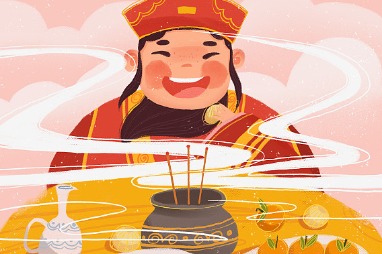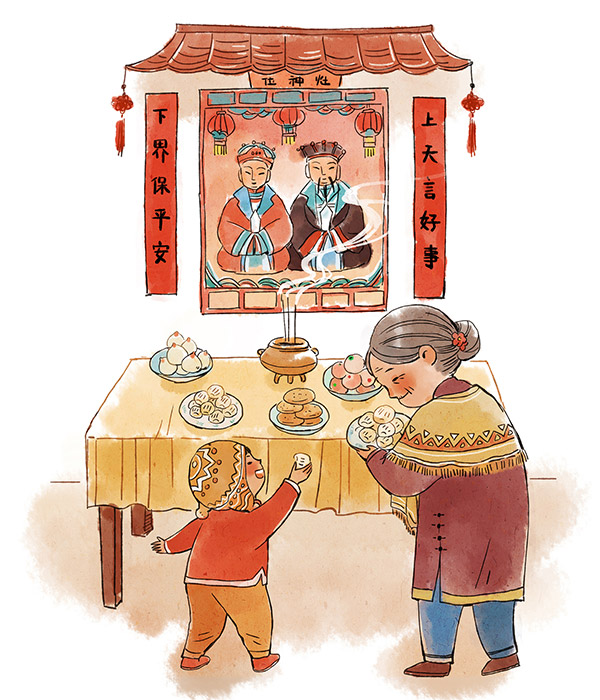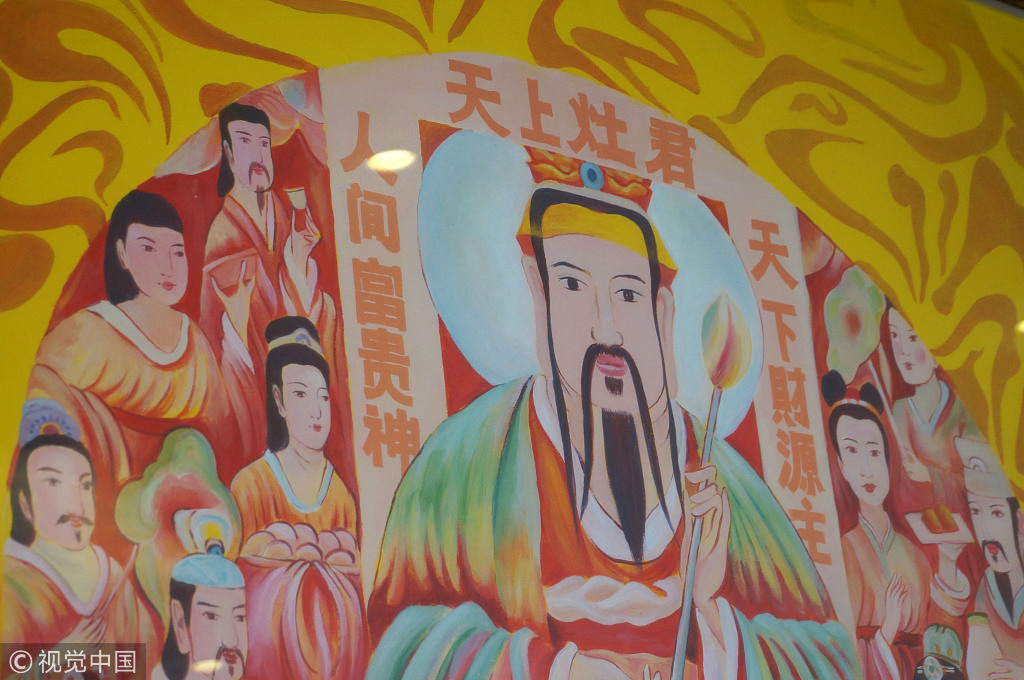
He is known as Zao Jun (灶君), the Kitchen God, a fair-faced celestial (神仙,shén xiān) who spends only a few days in the heavenly court of the Jade Emperor (玉帝,yù dì). For most of the year, he presides over the heart and hearth (灶台,zào tái) of earthly households, guarding the livestock, the servants, and most of all, the cooking stoves.

He is privy to the darkest secrets, and he sees all.
He listens to the backroom gossip (八卦内幕,bā guà nèi mù), the quarrels among the womenfolk. He witnesses the trickery of malingering servants, the secret stashes of food hidden for a stolen feast, the cutting of corners in the making of a complicated dish, the whispered rumors, the scandalous truths.
For those reasons, when it is time for him to ascend to make his annual report at the end of the lunar year, the whole household is suddenly alerted to his imminent departure and he is showered with food offerings (祭品,jì pǐn) to put him in the best of moods.
Yes. Even the gods must be bribed (贿赂,huì lù). In this case, the Kitchen God is sent off with an appropriate feast, all of which will include a final offering that is very sticky, and very sweet.
These sticky sweets, the foolish humans hope, will seal (封住,fēng zhù) his lips or sweeten his tongue and he will return in the new year with the appropriate bountiful blessings from heaven after making a positive assessment of their merits.
In kitchens large and small all across China, the preparations are starting as Zao Jun travels to report to his boss on the 23rd day of the last lunar month.
He has been doing this every year for the longest time, as far back as the Xia Dynasty more than 2,000 years before even Christ (耶稣,yē sū) was born. The Xia was only the first recorded dynasty in Chinese history, so it is likely Zao Jun has been around even longer than that.
Basically, the Kitchen God has been guardian of the stove ever since the Chinese started cooking indoors.

The day of his departure also signals the start to a flurry of preparations (准备,zhǔn bèi) for the official arrival of Spring a week away. His portrait (画像,huà xiàng), probably smoky from standing over the stove an entire year, will be taken down, smeared with honey (涂上蜜,tú shàng mì) and reverently (虔诚地,qián chéng de) burnt to send him on his way.
In the new year, a brand new portrait will go up on the wall.
Meanwhile, the kitchen and its inhabitants will be pretty busy. There is even a folk rhyme (民谣,mín yáo) to guide you through it all:
Twenty-third, pumpkin candies,
二十三 糖瓜粘
twenty-fourth, spring cleaning.
二十四 扫房日
Twenty-fifth, tofu time,
二十五 买豆腐
twenty-sixth, make meat stew.
二十六 切块肉
Twenty-seventh, kill the rooster,
二十七 杀只鸡
twenty-eighth, rise the dough.
二十八 把面发
Twenty-ninth, steam the buns,
二十九 蒸馒头
New Year's Eve, stay up late.
三十晚上 守一宿
New Year's Day, celebrate!
大年初一 扭一扭
Once Zao Jun leaves, replete with sticky pumpkin-shaped candies, the mops and dusters come out the next day and every dustball and cobweb industriously swept up (大扫除,dà sǎo chú) and removed.
The more nimble among the girls will start creating beautiful paper-cuts (剪纸,jiǎn zhǐ) from auspicious red paper. Fruits and flowers, the Chinese characters for happiness and spring, images of deer and bats and other lucky icons-all these will be pasted on windows and walls.
Those with good calligraphy (书法,shū fǎ) skills will be called upon to write couplets (对联,duì lián) of good wishes that will go across lintels and door frames. All on red paper.
In the meantime, an enormous amount of cooking will be done-starting with the slaughter of the chickens, ducks, pigs and goats to the soaking of soy beans for the making of tofu.

Another important task is the bun making. Steamed buns (馒头,mán tou) are very much part of the daily diet all year round, but the buns for the New Year will be decorated with dates (大枣,dà zǎo) and shaped into impressive works of art.
In my own household, my ayi (阿姨,housekeeper) and I will be creating flower buns cut from strips of dough artfully twisted into blossoms. Ayi comes from Henan, where the ladies are really good at turning dough into masterpieces of miniature architecture.
She has taught me how to press dried Chinese jujubes into the dough for instant effect. The red fruits add color and flavor as well. We also make piggy buns because the pig is, of course, a symbol of prosperity (繁荣,fán róng), especially since it will be the Year of the Pig.
In the southern regions of China, a sticky rice cake called nian gao (年糕) is also prepared. The basic recipe is golden syrup and glutinous rice flour. Occasionally, red beans and coconut milk are added and the mixture poured into containers lined with bamboo or coconut leaves. These days, elaborate jelly molds are used to shape the cakes, with fish molds being the most popular because fish is homophonic with "overflowing abundance (富余,fù yú)".
At this time of the year, rituals and symbolic foods become part of the celebrations and even though some may seem to be based simply on superstitions (迷信,mí xìn), they are still oddly comforting and very much part of the festivities that make a new lunar year so very special.
As for the Kitchen God, I'm pretty sure he enjoys the attention he gets every year and he never fails to return, duty completed, and ready for another year listening in on the household secrets.
Key words and phrases
贿赂:bribe
tā nà shí yīn wèi jiē shòu huì lù zài shòu dào diào chá
他那时因为接收贿赂在受到调查。
He was being investigated for receiving bribes.
tā bèi kòng huì lù yī wèi yín háng gāo jí zhí yuán
他被控贿赂一位银行高级职员。
He was accused of bribing a senior bank official.
对联:couplet
yī fù duì lián
一副对联
a couplet
If you have any problems with this article, please contact us at app@chinadaily.com.cn and we'll immediately get back to you.